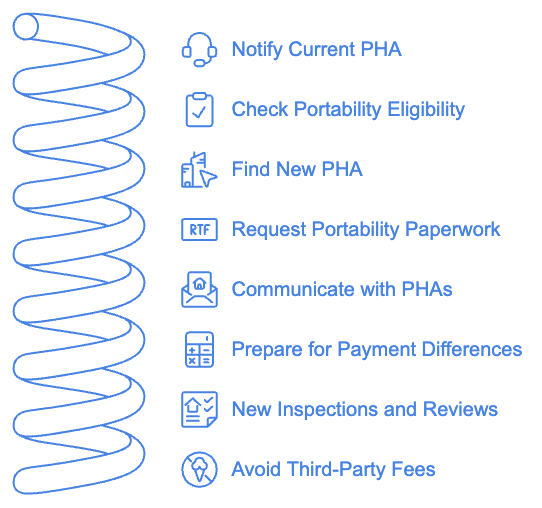
How to Report Housing Scams
November 7, 2024
How to Recognize and Avoid Fake Eviction Notices
November 18, 2024The Section 8 Housing Choice Voucher program provides rental assistance to low-income individuals and families, allowing them to choose housing in the private market. For those considering a move, transferring a Section 8 voucher to a new area is possible through a process called “portability.” However, moving with a voucher involves specific steps and coordination between public housing authorities (PHAs). At Section 8 Shield, we’ve put together this guide to help you understand how to transfer your Section 8 voucher safely and smoothly.
What Is Portability?
Portability allows Section 8 voucher holders to move to a new city, county, or state while keeping their rental assistance. This flexibility supports families who want to relocate for better job opportunities, access to better schools, or closer proximity to family. Portability transfers your voucher to a new PHA, which then takes over managing your housing assistance in the new location.
Understanding the portability process and following essential safety tips can help you make a successful move without risking your benefits.
Steps to Transfer Your Section 8 Voucher Safely
1. Notify Your Current Public Housing Authority (PHA) of Your Intent to Move
- Why It’s Important: Informing your PHA is the first step in the portability process. They’ll guide you through initial requirements and start the paperwork for transferring your voucher.
- What to Do: Contact your PHA in writing, and make sure they confirm your eligibility to move. Some PHAs require that you live in their jurisdiction for at least 12 months before you can transfer.
- Tip: Ask for a list of all documents you’ll need to complete the transfer, as requirements may vary by PHA.
2. Check if You’re Eligible for Portability
- Why It’s Important: Not all Section 8 voucher holders are immediately eligible to transfer. Some PHAs have residency requirements, so it’s crucial to confirm your eligibility early in the process.
- What to Do: Speak with your PHA to confirm that you meet all requirements for portability, such as any residency duration rules.
- Tip: Be prepared for a waiting period if you haven’t completed the required time in your current PHA’s jurisdiction.
3. Find a New Public Housing Authority in Your Destination Area
- Why It’s Important: Not all PHAs accept incoming portability cases, so you’ll need to confirm that the PHA in your new location participates in the program and can accommodate new residents.
- What to Do: Use HUD’s PHA locator tool to find contact information for PHAs in your desired area. Reach out to confirm they can accept portability transfers and ask about their process.
- Tip: Some PHAs have waiting lists for incoming transfers, so contact multiple PHAs in your target area to increase your options.
4. Request Portability Paperwork from Your Current PHA
- Why It’s Important: The portability paperwork includes the official documents needed to transfer your voucher to a new PHA.
- What to Do: Ask your current PHA to prepare and send portability paperwork to the receiving PHA in your new location. This typically includes verification of your voucher and income details.
- Tip: Follow up with both PHAs to ensure the paperwork is sent and received. Keep copies of all documents for your records.
5. Stay in Close Communication with Both PHAs
- Why It’s Important: Successful portability requires coordination between your current and new PHAs. Staying in contact helps prevent delays or misunderstandings.
- What to Do: Maintain regular contact with both PHAs throughout the transfer process, especially if there are any changes in your move-in date or housing plans.
- Tip: Document all communication, including emails and calls, to ensure you have a clear record of each step.
6. Prepare for Potential Differences in Payment Standards
- Why It’s Important: Different PHAs have different payment standards, which could impact the amount of rent assistance you receive in your new location.
- What to Do: Ask the receiving PHA about their payment standards and rent limits. This will help you understand how much assistance you’ll receive and whether it meets the rental prices in the new area.
- Tip: Research rental prices in the new area to ensure you’ll be able to find housing within the payment standard set by the new PHA.
7. Be Ready for New Inspections and Eligibility Reviews
- Why It’s Important: Your new PHA will likely require a new inspection of your chosen rental property and may review your eligibility again as part of their process.
- What to Do: Understand the inspection requirements in your new location and ensure that your chosen rental meets the PHA’s standards. The receiving PHA may also require updated income information or additional documents.
- Tip: Prepare all necessary documentation ahead of time, including recent pay stubs, tax returns, and other income records, to prevent delays.
8. Avoid Paying Fees to Third Parties Offering “Portability Services”
- Why It’s Important: Scammers often target Section 8 voucher holders by offering “portability services” for a fee. These services are unnecessary, as your PHA will handle the transfer at no cost.
- What to Do: Work directly with your PHAs to complete the transfer, and avoid any third-party services that offer assistance for a fee. Scammers may claim they can speed up the process, but this is false.
- Tip: Report any suspicious service providers to your PHA or HUD to help protect other renters from potential scams.
9. Tour Properties in Person When Possible
- Why It’s Important: Touring properties in person helps ensure you’re getting a legitimate rental and allows you to verify the property’s condition before signing a lease.
- What to Do: If you can’t tour in person, request a live virtual tour with the landlord or property manager. Confirm details like safety features, amenities, and neighborhood conditions during the tour.
- Tip: Avoid sending any deposits or payments before you’ve verified the property and signed an official lease.
10. Confirm Lease Terms and PHA Approval Before Moving In
Tip: Double-check that the lease includes all agreed terms, such as rent amount and responsibility for utilities, before signing.
Why It’s Important: Moving in before finalizing lease terms or receiving PHA approval can lead to issues with your rental assistance, including delays in payments.
What to Do: Work with your new PHA and the landlord to confirm that all lease terms align with PHA requirements. Wait for official PHA approval before moving in to ensure you’re covered by your voucher.

Safety Tips for a Successful Section 8 Transfer
Transferring your Section 8 voucher requires careful attention to avoid common pitfalls. Here are some additional tips for a smooth and safe transfer.
| Avoid Scammers Who Claim They Can “Guarantee” Housing | Scammers may target Section 8 participants by promising guaranteed housing or “faster processing” for a fee. Legitimate PHAs and landlords will never charge fees to speed up the process or guarantee housing. |
| Do Not Provide Personal Information to Unknown Parties | Only share personal information with your PHA, legitimate landlords, and verified property management companies. Avoid sharing sensitive details like Social Security numbers or bank information with anyone claiming to be a “voucher transfer service.” |
| Stay Informed About Local Rental Laws | Rental laws and tenant rights vary by state and municipality. Familiarize yourself with tenant rights and rental laws in your new area to ensure you’re aware of protections and responsibilities. |
| Work Directly with Verified Landlords or Property Managers | Many PHAs keep lists of approved landlords or property managers. Contact these resources for your housing search, and always verify landlord identities before making any payments. |
| Understand Your Rights and Responsibilities as a Section 8 Voucher Holder | Knowing your rights helps you spot potential scams or misuse. Speak with your PHA if you have any questions about your rights, eligibility, or responsibilities. |
What to Do If You Encounter Problems
If you experience delays, issues with the new PHA, or suspect a scam during the transfer, here’s what you can do:
- Contact Your Current PHA: Your current PHA can often assist with issues, especially if there’s confusion or delay on the receiving end.
- Reach Out to HUD: If your PHA is unresponsive or you’re facing significant obstacles, contact HUD for additional assistance.
- Report Scams or Fraudulent Activity: Report any suspected scams or fraud to your PHA, HUD, or local consumer protection agencies.
Transferring Your Section 8 Voucher Safely
Moving with a Section 8 voucher can be a complex process, but following these steps can help make it smooth and safe. Portability offers valuable flexibility for Section 8 participants, allowing you to relocate while maintaining your housing assistance. Section 8 Shield is here to help you understand the process, avoid scams, and make informed decisions during your transfer.
By working closely with your PHAs, confirming property details, and protecting your personal information, you can safely and confidently move to your new home with the security of your Section 8 assistance intact.




